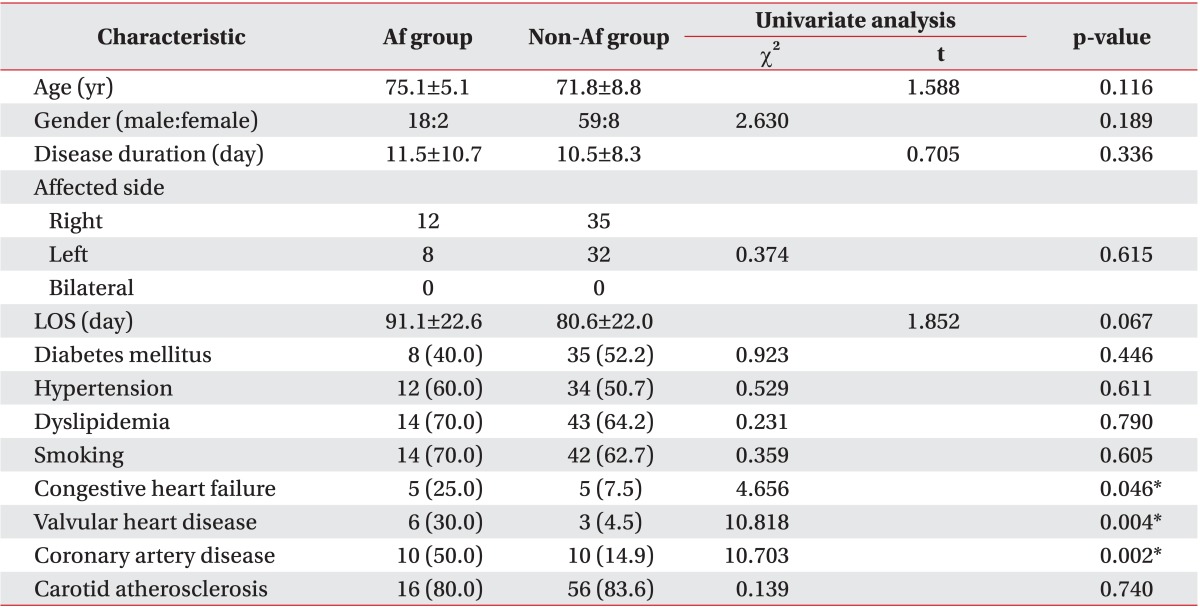1. Shibazaki K, Kimura K, Aoki J, Saji N, Sakai K. Early initiation of new oral anticoagulants in acute stroke and TIA patients with nonvalvular atrial fibrillation. J Neurol Sci. 2013; 331:90–93. PMID:
23743245.

2. Feinberg WM, Blackshear JL, Laupacis A, Kronmal R, Hart RG. Prevalence, age distribution, and gender of patients with atrial fibrillation. Analysis and implications. Arch Intern Med. 1995; 155:469–473. PMID:
7864703.

3. Kannel WB, Wolf PA, Benjamin EJ, Levy D. Prevalence, incidence, prognosis, and predisposing conditions for atrial fibrillation: population-based estimates. Am J Cardiol. 1998; 82:2N–9N.
4. Wolf PA, Abbott RD, Kannel WB. Atrial fibrillation as an independent risk factor for stroke: the Framingham Study. Stroke. 1991; 22:983–988. PMID:
1866765.

5. Petersen P. Thromboembolic complications in atrial fibrillation. Stroke. 1990; 21:4–13. PMID:
2405547.

6. Go AS. The epidemiology of atrial fibrillation in elderly persons: the tip of the iceberg. Am J Geriatr Cardiol. 2005; 14:56–61. PMID:
15785146.

7. Wolf PA, Dawber TR, Thomas HE Jr, Kannel WB. Epidemiologic assessment of chronic atrial fibrillation and risk of stroke: the Framingham study. Neurology. 1978; 28:973–977. PMID:
570666.

8. Lin HJ, Wolf PA, Kelly-Hayes M, Beiser AS, Kase CS, Benjamin EJ, et al. Stroke severity in atrial fibrillation: the Framingham Study. Stroke. 1996; 27:1760–1764. PMID:
8841325.
9. Kaarisalo MM, Immonen-Raiha P, Marttila RJ, Salomaa V, Kaarsalo E, Salmi K, et al. Atrial fibrillation and stroke: mortality and causes of death after the first acute ischemic stroke. Stroke. 1997; 28:311–315. PMID:
9040681.
10. Sandercock P, Bamford J, Dennis M, Burn J, Slattery J, Jones L, et al. Atrial fibrillation and stroke: prevalence in different types of stroke and influence on early and long term prognosis (Oxfordshire community stroke project). BMJ. 1992; 305:1460–1465. PMID:
1493391.

11. Candelise L, Pinardi G, Morabito A. The Italian Acute Stroke Study Group. Mortality in acute stroke with atrial fibrillation. Stroke. 1991; 22:169–174. PMID:
2003280.
12. Gustafsson C, Britton M. Pathogenetic mechanism of stroke in non-valvular atrial fibrillation: follow-up of stroke patients with and without atrial fibrillation. J Intern Med. 1991; 230:11–16. PMID:
2066706.

13. Fisher CM. Reducing risks of cerebral embolism. Geriatrics. 1979; 34:59–61. PMID:
761771.
14. Krahn AD, Manfreda J, Tate RB, Mathewson FA, Cuddy TE. The natural history of atrial fibrillation: incidence, risk factors, and prognosis in the Manitoba Follow-Up Study. Am J Med. 1995; 98:476–484. PMID:
7733127.

15. Gonzalez Toledo ME, Klein FR, Riccio PM, Cassara FP, Munoz Giacomelli F, Racosta JM, et al. Atrial fibrillation detected after acute ischemic stroke: evidence supporting the neurogenic hypothesis. J Stroke Cerebrovasc Dis. 2013; 22:e486–e491. PMID:
23800494.
16. Fuster V, Ryden LE, Cannom DS, Crijns HJ, Curtis AB, Ellenbogen KA, et al. ACC/AHA/ESC 2006 Guidelines for the Management of Patients with Atrial Fibrillation: a report of the American College of Cardiology/American Heart Association Task Force on Practice Guidelines and the European Society of Cardiology Committee for Practice Guidelines (Writing Committee to Revise the 2001 Guidelines for the Management of Patients With Atrial Fibrillation): developed in collaboration with the European Heart Rhythm Association and the Heart Rhythm Society. Circulation. 2006; 114:e257–e354. PMID:
16908781.
17. Chaudhuri G, Harvey RF, Sulton LD, Lambert RW. Computerized tomography head scans as predictors of functional outcome of stroke patients. Arch Phys Med Rehabil. 1988; 69:496–498. PMID:
3389988.
18. Granger CV, Cotter AC, Hamilton BB, Fiedler RC. Functional assessment scales: a study of persons after stroke. Arch Phys Med Rehabil. 1993; 74:133–138. PMID:
8431095.
19. Hamilton BB, Laughlin JA, Fiedler RC, Granger CV. Interrater reliability of the 7-level functional independence measure (FIM). Scand J Rehabil Med. 1994; 26:115–119. PMID:
7801060.
20. Shin YI, Kim YH, Seo JH, Kim YC. The influencing factors on FIM score in the patients with stroke. J Korean Acad Rehabil Med. 1996; 20:833–838.
21. Granger CV, Albrecht GL, Hamilton BB. Outcome of comprehensive medical rehabilitation: measurement by PULSES profile and the Barthel Index. Arch Phys Med Rehabil. 1979; 60:145–154. PMID:
157729.
22. Marshall SC, Heisel B, Grinnell D. Validity of the PULSES profile compared with the Functional Independence Measure for measuring disability in a stroke rehabilitation setting. Arch Phys Med Rehabil. 1999; 80:760–765. PMID:
10414759.

23. Kim KT, Kang MJ, Lee HN, An JD, Cho C, Bae J. Clinical factors associated with functional status at discharge in stroke patients. J Korean Acad Rehabil Med. 2003; 27:300–308.
24. Chen CL, Tang FT, Chen HC, Chung CY, Wong MK. Brain lesion size and location: effects on motor recovery and functional outcome in stroke patients. Arch Phys Med Rehabil. 2000; 81:447–452. PMID:
10768534.

25. Chua KS, Kong KH. Functional outcome in brain stem stroke patients after rehabilitation. Arch Phys Med Rehabil. 1996; 77:194–197. PMID:
8607746.

26. Kong KH, Chua KS, Tow AP. Clinical characteristics and functional outcome of stroke patients 75 years old and older. Arch Phys Med Rehabil. 1998; 79:1535–1539. PMID:
9862295.

27. Miyai I, Suzuki T, Kang J, Volpe BT. Improved functional outcome in patients with hemorrhagic stroke in putamen and thalamus compared with those with stroke restricted to the putamen or thalamus. Stroke. 2000; 31:1365–1369. PMID:
10835458.

28. Roth EJ. Heart disease in patients with stroke. Part II: Impact and implications for rehabilitation. Arch Phys Med Rehabil. 1994; 75:94–101. PMID:
8291971.

29. Arboix A, Garcia-Eroles L, Comes E, Oliveres M, Targa C, Balcells M, et al. Importance of cardiovascular risk profile for in-hospital mortality due to cerebral infarction. Rev Esp Cardiol. 2008; 61:1020–1029. PMID:
18817678.

30. Paciaroni M, Agnelli G, Ageno W, Caso V, Corea F, Lanari A, et al. Risk factors for cerebral ischemic events in patients with atrial fibrillation on warfarin for stroke prevention. Atherosclerosis. 2010; 212:564–566. PMID:
20599199.





 PDF
PDF ePub
ePub Citation
Citation Print
Print







 XML Download
XML Download